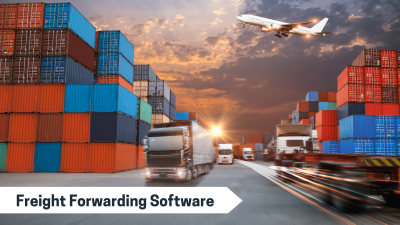A coordinated system of importers, exporters, and transportation teams is required to move deliveries from point A to point B. This procedure is held together by freight forwarding software. This software is more crucial than ever, particularly in the wake of the worldwide epidemic, when supply chain difficulties are still a hot topic.
Delivery tracking, on-time shipping, and customer satisfaction are all made possible with the correct freight management software. But if you employ the wrong software or none, you can end up with lost shipments, laborious tracking procedures, and a subpar customer experience. Your freight industry might gain a competitive edge by putting money into a reliable freight forwarding solution. This article will discuss freight forwarding processes and boost profitability with Freight Software with BoxOn.
How Does Freight Forwarding Software Work?
Freight forwarders and logistics operations specialists utilize freight forwarding software as a tool to keep track of all the details of arriving and leaving goods. Freight management software makes it possible to track data digitally and share it with the appropriate parties rather than having to do everything by hand. Ultimately, freight forwarding software is created to free up time for your team and enhance the delivery experience for the freight industry.
Software for freight forwarding also lessens, and in some cases eliminates, the possibility of human error. This program makes sure that everyone in your team is always aware of the precise location of each item in the transportation process by tracking shipments down to the stock-keeping unit (SKU) level. Your ability to cultivate relationships at each point of the customer journey is eventually increased thanks to this knowledge, which also helps you optimize delivery estimates and customer communication.
Freight forwarding software’s primary capabilities and functions.
The primary features and functions of each, whether you’re working with local or international freight solutions, are similar. These software solutions’ primary objective is to streamline the tracking of shipments for network partners including suppliers as well as logistics teams. Among them are:
- Automating the delivery of emails with real-time updates.
- Provides customized and recurring shipping reports.
- Real-time, SKU-level tracking of freight.
- delivering packages with personalized views based on the intended purpose.
1. Automated reporting and current information:
Technology for freight forwarding is centered on automation and real-time reporting. With automated shipment reporting, your team may stop sending emails each time a shipment is updated. For your entire supply chain network, this level of automation is quite advantageous. Your crew does not need to slow down to track each delivery as it arrives. This enables the freight industry to manage, move, and track more cargo concurrently.
2. SKU-Level visibility and shipment tracking:
A special set of digits called an SKU is used by merchants to track products when they move from one facility to another. You can always be sure that all your products have made it from one facility to the next by using good freight forwarding software that incorporates freight tracking down to the SKU level. Furthermore, corporate logistics don’t interfere with the overall customer experience thanks to SKU-level visibility and shipment tracking. Additionally, by enabling tracking for your teams, you can reduce the volume of calls and emails your customer care staff receives regarding shipment estimations. As a result, your clients will remain satisfied, and they will have more time to handle other kinds of calls.
3. Applications integrated with other applications:
Your entire freight forwarding operation can incorporate freight management software. Because of this, the ideal platform can adjust to the general requirements of your logistics business. Freight forwarding software links into your existing supply chain procedures without difficulty by interacting with other programs. The integration of freight forwarding software with systems that can pull customs information may be especially advantageous for businesses that transport goods internationally as part of an international supply chain. This can simplify third-party logistics and your inventory management.
BoxOn’s freight solutions can also assist you in abiding by import laws by integrating with your current documents and alerting you to regulatory revisions.
4. Documents and Reports That Can Be Modified:
- Documents must be produced and given at every stage of the supply chain. For these papers, you have a few distinct choices. You could: Create every document and report separately, listing the goods, their costs, and other routing details to ensure that your records are as accurate and helpful as possible.
- Utilize time-saving generic templates that perform the work without requiring personalized input.
- Utilize technology to quickly and simply create documents and reports that are personalized.
- The third choice is undoubtedly the best one. The ability to create templates and edit them as necessary is provided by freight forwarding software.
Conclusion:
A robust solution should be used to address significant supply chain problems. Your team will spend less time, energy, and money if you buy freight forwarding software. The investment afterward enables you to fulfill the diverse range of requests from your clients. By attending to those needs, you enhance the general customer experience, boost the number of devoted clients you attract annually, and ultimately expand your organization.
For more information book a demo with BoxOn Logistics.https://www.boxonlogistics.com/request-demo/






COMMENTS